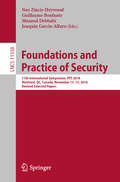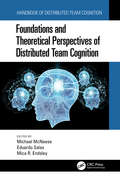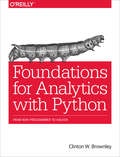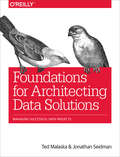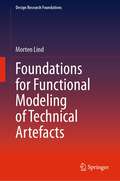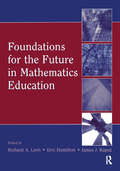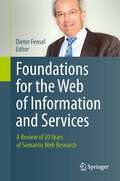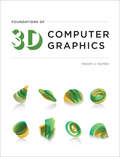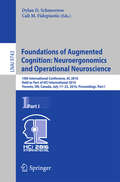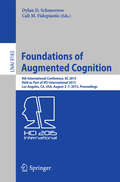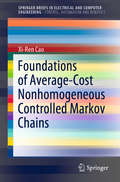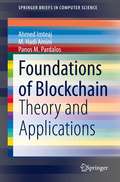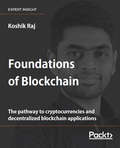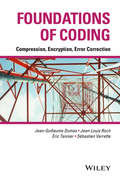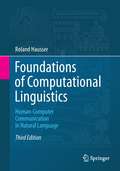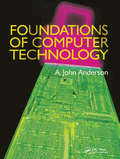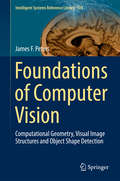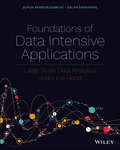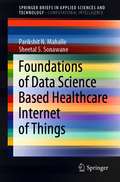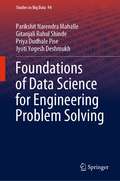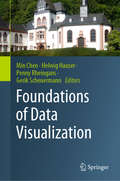- Table View
- List View
Foundations and Practice of Security: 11th International Symposium, FPS 2018, Montreal, QC, Canada, November 13–15, 2018, Revised Selected Papers (Lecture Notes in Computer Science #11358)
by Nur Zincir-Heywood Guillaume Bonfante Mourad Debbabi Joaquin Garcia-AlfaroThis book constitutes the revised selected papers of the 11th International Symposium on Foundations and Practice of Security, FPS 2018, held in Montreal, QC, Canada, in March 2018. The 16 full papers, 1 short paper, 1 position paper and 2 invited papers presented in this book, were carefully reviewed and selected from 51 submissions. They cover a range of topics including mobile security; cloud security and big data; IoT security; software security, malware analysis, and vulnerability detection; cryptography; cyber physical security and hardware security; and access control.
Foundations and Theoretical Perspectives of Distributed Team Cognition
by Michael D. McNeese; Eduardo Salas; Mica R. EndsleyThe background and interwoven streams of team cognition and distributed cognition fermenting together has wielded new nuances of exploration, which continue to be relevant for a theoretical understanding of team phenomena. Foundations and Theoretical Perspectives of Distributed Teams Cognition looks at fundamentals, theoretical concepts, and how theory informs perspectives of thinking for distributed team cognition. The chapters yield a broad understanding of the nature of diverse thinking and insights into technologies, foundations, and theoretical perspectives of distributed team cognition. Features Generates historical patterns and significance that compose developmental trajectories Explains multiple perspectives that incorporate an interdisciplinary understanding that specifies diverse theories Identifies and develops particular challenges resident within team simulation studies and then illustrates research frameworks Highlights and reviews how team simulations are used to produce dynamic experimental results Investigates and studies research variables within distributed team cognition
Foundations for Analytics with Python: From Non-Programmer to Hacker
by BrownleyIf you're like many of Excel's 750 million users, you want to do more with your data--like repeating similar analyses over hundreds of files, or combining data in many files for analysis at one time. This practical guide shows ambitious non-programmers how to automate and scale the processing and analysis of data in different formats--by using Python.After author Clinton Brownley takes you through Python basics, you'll be able to write simple scripts for processing data in spreadsheets as well as databases. You'll also learn how to use several Python modules for parsing files, grouping data, and producing statistics. No programming experience is necessary.Create and run your own Python scripts by learning basic syntaxUse Python's csv module to read and parse CSV filesRead multiple Excel worksheets and workbooks with the xlrd modulePerform database operations in MySQL or with the mysqlclient moduleCreate Python applications to find specific records, group data, and parse text filesBuild statistical graphs and plots with matplotlib, pandas, ggplot, and seabornProduce summary statistics, and estimate regression and classification modelsSchedule your scripts to run automatically in both Windows and Mac environments
Foundations for Architecting Data Solutions: Managing Successful Data Projects
by Ted Malaska Jonathan SeidmanWhile many companies ponder implementation details such as distributed processing engines and algorithms for data analysis, this practical book takes a much wider view of big data development, starting with initial planning and moving diligently toward execution. Authors Ted Malaska and Jonathan Seidman guide you through the major components necessary to start, architect, and develop successful big data projects.Everyone from CIOs and COOs to lead architects and developers will explore a variety of big data architectures and applications, from massive data pipelines to web-scale applications. Each chapter addresses a piece of the software development life cycle and identifies patterns to maximize long-term success throughout the life of your project.Start the planning process by considering the key data project typesUse guidelines to evaluate and select data management solutionsReduce risk related to technology, your team, and vague requirementsExplore system interface design using APIs, REST, and pub/sub systemsChoose the right distributed storage system for your big data systemPlan and implement metadata collections for your data architectureUse data pipelines to ensure data integrity from source to final storageEvaluate the attributes of various engines for processing the data you collect
Foundations for Functional Modeling of Technical Artefacts (Design Research Foundations)
by Morten LindThis monograph provides a new framework for modelling goals and functions of control systems. It demonstrates how to use means-end concepts and various aspects of action to describe the relations between the structure, dispositions, functions, and goals of technical systems and with human action. The author developed this approach as part of his research on Multilevel Flow Modelling (MFM). He based the framework on concepts of action and means-end analysis drawing on existing theories from several areas of study, including philosophical logic, semiotics, and phenomenological approaches to social science. Here, he applies it to three modeling situations related to the interaction of technical artefacts and humans. One involves the relation between designer and artefact, another the relation between technical artefact and its user, and the third the relation between a natural object and its user. All three are relevant for modelling complex automated processes interacting with human operators. The book also discusses challenges when applying the foundations for modelling of technical artefacts. Overall, it provides a cross disciplinary integration of several fields of knowledge. These disciplines include intelligent process control, human machine interaction, and process and automation design. As a result, researchers and graduate students in computer science, engineering, and philosophy of technology will find it a valuable resource.
Foundations for the Future in Mathematics Education
by Richard A. Lesh; Eric Hamilton; James J. KaputThe central question addressed in Foundations for the Future in Mathematics Education is this: What kind of understandings and abilities should be emphasized to decrease mismatches between the narrow band of mathematical understandings and abilities that are emphasized in mathematics classrooms and tests, and those that are needed for success beyond school in the 21st century? This is an urgent question. In fields ranging from aeronautical engineering to agriculture, and from biotechnologies to business administration, outside advisors to future-oriented university programs increasingly emphasize the fact that, beyond school, the nature of problem-solving activities has changed dramatically during the past twenty years, as powerful tools for computation, conceptualization, and communication have led to fundamental changes in the levels and types of mathematical understandings and abilities that are needed for success in such fields. For K-12 students and teachers, questions about the changing nature of mathematics (and mathematical thinking beyond school) might be rephrased to ask: If the goal is to create a mathematics curriculum that will be adequate to prepare students for informed citizenship—as well as preparing them for career opportunities in learning organizations, in knowledge economies, in an age of increasing globalization—how should traditional conceptions of the 3Rs be extended or reconceived? Overall, this book suggests that it is not enough to simply make incremental changes in the existing curriculum whose traditions developed out of the needs of industrial societies. The authors, beyond simply stating conclusions from their research, use results from it to describe promising directions for a research agenda related to this question. The volume is organized in three sections: *Part I focuses on naturalistic observations aimed at clarifying what kind of “mathematical thinking” people really do when they are engaged in “real life” problem solving or decision making situations beyond school. *Part II shifts attention toward changes that have occurred in kinds of elementary-but-powerful mathematical concepts, topics, and tools that have evolved recently—and that could replace past notions of “basics” by providing new foundations for the future. This section also initiates discussions about what it means to “understand” the preceding ideas and abilities. *Part III extends these discussions about meaning and understanding—and emphasizes teaching experiments aimed at investigating how instructional activities can be designed to facilitate the development of the preceding ideas and abilities. Foundations for the Future in Mathematics Education is an essential reference for researchers, curriculum developers, assessment experts, and teacher educators across the fields of mathematics and science education.
Foundations for the Web of Information and Services: A Review of 20 Years of Semantic Web Research
by Dieter FenselIn the mid 1990s, Tim Berners-Lee had the idea of developing the World Wide Web into a "Semantic Web", a web of information that could be interpreted by machines in order to allow the automatic exploitation of data, which until then had to be done by humans manually. One of the first people to research topics related to the Semantic Web was Professor Rudi Studer. From the beginning, Rudi drove projects like ONTOBROKER and On-to-Knowledge, which later resulted in W3C standards such as RDF and OWL. By the late 1990s, Rudi had established a research group at the University of Karlsruhe, which later became the nucleus and breeding ground for Semantic Web research, and many of today's well-known research groups were either founded by his disciples or benefited from close cooperation with this think tank. In this book, published in celebration of Rudi's 60th birthday, many of his colleagues look back on the main research results achieved during the last 20 years. Under the editorship of Dieter Fensel, once one of Rudi's early PhD students, an impressive list of contributors and contributions has been collected, covering areas like Knowledge Management, Ontology Engineering, Service Management, and Semantic Search. Overall, this book provides an excellent overview of the state of the art in Semantic Web research, by combining historical roots with the latest results, which may finally make the dream of a "Web of knowledge, software and services" come true.
Foundations of 3D Computer Graphics
by Steven J. GortlerAn introduction to the basic concepts of 3D computer graphics that offers a careful mathematical exposition within a modern computer graphics application programming interface.Computer graphics technology is an amazing success story. Today, all of our PCs are capable of producing high-quality computer-generated images, mostly in the form of video games and virtual-life environments; every summer blockbuster movie includes jaw-dropping computer generated special effects. This book explains the fundamental concepts of 3D computer graphics. It introduces the basic algorithmic technology needed to produce 3D computer graphics, and covers such topics as understanding and manipulating 3D geometric transformations, camera transformations, the image-rendering process, and materials and texture mapping. It also touches on advanced topics including color representations, light simulation, dealing with geometric representations, and producing animated computer graphics. The book takes special care to develop an original exposition that is accessible and concise but also offers a clear explanation of the more difficult and subtle mathematical issues. The topics are organized around a modern shader-based version of OpenGL, a widely used computer graphics application programming interface that provides a real-time “rasterization-based” rendering environment. Each chapter concludes with exercises. The book is suitable for a rigorous one-semester introductory course in computer graphics for upper-level undergraduates or as a professional reference. Readers should be moderately competent programmers and have had some experience with linear algebra. After mastering the material presented, they will be on the path to expertise in an exciting and challenging field.
Foundations of Augmented Cognition: Neuroergonomics and Operational Neuroscience
by Cali M. Fidopiastis Dylan D. SchmorrowThe 13th International Conference on Human-Computer Interaction, HCI Inter- tional 2009, was held in San Diego, California, USA, July 19-24, 2009, jointly with the Symposium on Human Interface (Japan) 2009, the 8th International Conference on Engineering Psychology and Cognitive Ergonomics, the 5th International Conference on Universal Access in Human-Computer Interaction, the Third International Conf- ence on Virtual and Mixed Reality, the Third International Conference on Internati- alization, Design and Global Development, the Third International Conference on Online Communities and Social Computing, the 5th International Conference on Augmented Cognition, the Second International Conference on Digital Human Mod- ing, and the First International Conference on Human Centered Design. A total of 4,348 individuals from academia, research institutes, industry and gove- mental agencies from 73 countries submitted contributions, and 1,397 papers that were judged to be of high scientific quality were included in the program. These papers - dress the latest research and development efforts and highlight the human aspects of the design and use of computing systems. The papers accepted for presentation thoroughly cover the entire field of human-computer interaction, addressing major advances in knowledge and effective use of computers in a variety of application areas.
Foundations of Augmented Cognition
by Dylan D. Schmorrow Cali M. FidopiastisThis book constitutes the proceedings of the 9th International Conference on the Foundations of Augmented Cognition, AC 2015, held as part of the 17th International Conference on Human-Computer Interaction, HCII 2015, which took place in Los Angeles, CA, USA, in August 2015. HCII 2015 received a total of 4843 submissions, of which 1462 papers and 246 posters were accepted for publication after a careful reviewing process. These papers address the latest research and development efforts and highlight the human aspects of design and use of computing systems. The papers thoroughly cover the entire field of Human-Computer Interaction, addressing major advances in knowledge and effective use of computers in a variety of application areas. The 78 papers presented in the AC 2015 proceedings address the following major topics: cognitive performance and work load, BCI and operational neuroscience, cognition, perception and emotion measurement, adaptive and tutoring training, applications of augmented cognition.
Foundations of Augmented Cognition: 9th International Conference, AC 2015, Held as Part of HCI International 2015, Los Angeles, CA, USA, August 2-7, 2015, Proceedings (Lecture Notes in Computer Science #9183)
by Dylan D. Schmorrow Cali M. FidopiastisThis book constitutes the proceedings of the 9th International Conference on the Foundations of Augmented Cognition, AC 2015, held as part of the 17th International Conference on Human-Computer Interaction, HCII 2015, which took place in Los Angeles, CA, USA, in August 2015. HCII 2015 received a total of 4843 submissions, of which 1462 papers and 246 posters were accepted for publication after a careful reviewing process. These papers address the latest research and development efforts and highlight the human aspects of design and use of computing systems. The papers thoroughly cover the entire field of Human-Computer Interaction, addressing major advances in knowledge and effective use of computers in a variety of application areas. The 78 papers presented in the AC 2015 proceedings address the following major topics: cognitive performance and work load, BCI and operational neuroscience, cognition, perception and emotion measurement, adaptive and tutoring training, applications of augmented cognition.
Foundations of Average-Cost Nonhomogeneous Controlled Markov Chains (SpringerBriefs in Electrical and Computer Engineering)
by Xi-Ren CaoThis Springer brief addresses the challenges encountered in the study of the optimization of time-nonhomogeneous Markov chains. It develops new insights and new methodologies for systems in which concepts such as stationarity, ergodicity, periodicity and connectivity do not apply. This brief introduces the novel concept of confluencity and applies a relative optimization approach. It develops a comprehensive theory for optimization of the long-run average of time-nonhomogeneous Markov chains. The book shows that confluencity is the most fundamental concept in optimization, and that relative optimization is more suitable for treating the systems under consideration than standard ideas of dynamic programming. Using confluencity and relative optimization, the author classifies states as confluent or branching and shows how the under-selectivity issue of the long-run average can be easily addressed, multi-class optimization implemented, and Nth biases and Blackwell optimality conditions derived. These results are presented in a book for the first time and so may enhance the understanding of optimization and motivate new research ideas in the area.
Foundations of Blockchain: Theory and Applications (SpringerBriefs in Computer Science)
by Ahmed Imteaj M. Hadi Amini Panos M. PardalosThis book provides a comprehensive analysis of fundamental topics related to blockchain. Throughout, the authors explore different vital issues and specific areas of blockchain. For convenience, the authors present the elementary description, visualize the working procedure of blockchain paradigm, and highlight the areas it can be applied in real life. They explain the blockchain process from a diverse perspective i.e. distributed Internet of Things (IoT), interdependent networks, intelligent mining, etc. They also analyze the interconnection of a blockchain network and such novel research areas to show a pathway towards a new research direction. This book also holds the core challenges and open research issues of blockchain technology, considering existing applications. Chapters include consensus mechanisms of blockchain, blockchain applicability in centralized and decentralized internet of things, blockchain interoperability from the perspective of interdependent networks, and blockchain for resource-constrained devices.Specifies the importance of theoretical methods in dealing with problems in the context of blockchain for interdependent decision making;Provides a comprehensive investigation of blockchain algorithms and the recently developed methods based on this algorithm;Provides basics and mathematical foundations needed to learn and deploy blockchain.
Foundations of Blockchain: The pathway to cryptocurrencies and decentralized blockchain applications
by Koshik RajReaders should be comfortable with general security terms, but no knowledge of cryptography or decentralized application is assumed. Although the book begins with all the basic concepts, a hands-on python programming, and theoretical networking knowledge, would speed up the reading process.
Foundations of Coding
by Éric Tannier Jean-Guillaume Dumas Jean-Louis Roch Sébastien VarretteOffers a comprehensive introduction to the fundamentalstructures and applications of a wide range of contemporary codingoperationsThis book offers a comprehensive introduction to the fundamentalstructures and applications of a wide range of contemporary codingoperations. This text focuses on the ways to structure informationso that its transmission will be in the safest, quickest, and mostefficient and error-free manner possible. All coding operations arecovered in a single framework, with initial chapters addressingearly mathematical models and algorithmic developments which led tothe structure of code. After discussing the general foundations ofcode, chapters proceed to cover individual topics such as notionsof compression, cryptography, detection, and correction codes. Bothclassical coding theories and the most cutting-edge models areaddressed, along with helpful exercises of varying complexities toenhance comprehension. Explains how to structure coding information so that itstransmission is safe, error-free, efficient, and fastIncludes a pseudo-code that readers may implement in theirpreferential programming languageFeatures descriptive diagrams and illustrations, and almost 150exercises, with corrections, of varying complexity to enhancecomprehensionFoundations of Coding: Compression, Encryption,Error-Correction is an invaluable resource for understandingthe various ways information is structured for its secure andreliable transmission in the 21st-century world.
Foundations of Computational Linguistics
by Roland HausserThe central task of a future-oriented computational linguistics is the development of cognitive machines which humans can freely talk with in their respective natural language. In the long run, this task will ensure the development of a functional theory of language, an objective method of verification, and a wide range of practical applications. Natural communication requires not only verbal processing, but also non-verbal perception and action. Therefore the content of this textbook is organized as a theory of language for the construction of talking robots. The main topic is the mechanism of natural language communication in both the speaker and the hearer. In the third edition the author has modernized the text, leaving the overview of traditional, theoretical, and computational linguistics, analytic philosophy of language, and mathematical complexity theory with their historical backgrounds intact. The format of the empirical analyses of English and German syntax and semantics has been adapted to current practice; and Chaps. 22-24 have been rewritten to focus more sharply on the construction of a talking robot.
Foundations of Computer Technology
by Alexander John AndersonFoundations of Computer Technology is an easily accessible introduction to the architecture of computers and peripherals. This textbook clearly and completely explains modern computer systems through an approach that integrates components, systems, software, and design. It provides a succinct, systematic, and readable guide to computers, providing a springboard for students to pursue more detailed technology subjects.This volume focuses on hardware elements within a computer system and the impact of software on its architecture. It discusses practical aspects of computer organization (structure, behavior, and design) delivering the necessary fundamentals for electrical engineering and computer science students. The book not only lists a wide range of terms, but also explains the basic operations of components within a system, aided by many detailed illustrations. Material on modern technologies is combined with a historical perspective, delivering a range of articles on hardware, architecture and software, programming methodologies, and the nature of operating systems. It also includes a unified treatment on the entire computing spectrum, ranging from microcomputers to supercomputers.Each section features learning objectives and chapter outlines. Small glossary entries define technical terms and each chapter ends with an alphabetical list of key terms for reference and review. Review questions also appear at the end of each chapter and project questions inspire readers to research beyond the text. Short, annotated bibliographies direct students to additional useful reading.
Foundations of Computer Vision
by James F. PetersThis book introduces the fundamentals of computer vision (CV), with a focus on extracting useful information from digital images and videos. Including a wealth of methods used in detecting and classifying image objects and their shapes, it is the first book to apply a trio of tools (computational geometry, topology and algorithms) in solving CV problems, shape tracking in image object recognition and detecting the repetition of shapes in single images and video frames. Computational geometry provides a visualization of topological structures such as neighborhoods of points embedded in images, while image topology supplies us with structures useful in the analysis and classification of image regions. Algorithms provide a practical, step-by-step means of viewing image structures. The implementations of CV methods in Matlab and Mathematica, classification of chapter problems with the symbols (easily solved) and (challenging) and its extensive glossary of key words, examples and connections with the fabric of CV make the book an invaluable resource for advanced undergraduate and first year graduate students in Engineering, Computer Science or Applied Mathematics. It offers insights into the design of CV experiments, inclusion of image processing methods in CV projects, as well as the reconstruction and interpretation of recorded natural scenes.
Foundations Of Data Exchange
by Marcelo ArenasThe problem of exchanging data between different databases with different schemas is an area of immense importance. Consequently data exchange has been one of the most active research topics in databases over the past decade. Foundational questions related to data exchange largely revolve around three key problems: how to build target solutions; how to answer queries over target solutions; and how to manipulate schema mappings themselves? The last question is also known under the name 'metadata management', since mappings represent metadata, rather than data in the database. In this book the authors summarize the key developments of a decade of research. Part I introduces the problem of data exchange via examples, both relational and XML; Part II deals with exchanging relational data; Part III focuses on exchanging XML data; and Part IV covers metadata management.
Foundations of Data Intensive Applications: Large Scale Data Analytics under the Hood
by Supun Kamburugamuve Saliya EkanayakePEEK “UNDER THE HOOD” OF BIG DATA ANALYTICS The world of big data analytics grows ever more complex. And while many people can work superficially with specific frameworks, far fewer understand the fundamental principles of large-scale, distributed data processing systems and how they operate. In Foundations of Data Intensive Applications: Large Scale Data Analytics under the Hood, renowned big-data experts and computer scientists Drs. Supun Kamburugamuve and Saliya Ekanayake deliver a practical guide to applying the principles of big data to software development for optimal performance. The authors discuss foundational components of large-scale data systems and walk readers through the major software design decisions that define performance, application type, and usability. You???ll learn how to recognize problems in your applications resulting in performance and distributed operation issues, diagnose them, and effectively eliminate them by relying on the bedrock big data principles explained within. Moving beyond individual frameworks and APIs for data processing, this book unlocks the theoretical ideas that operate under the hood of every big data processing system. Ideal for data scientists, data architects, dev-ops engineers, and developers, Foundations of Data Intensive Applications: Large Scale Data Analytics under the Hood shows readers how to: Identify the foundations of large-scale, distributed data processing systems Make major software design decisions that optimize performance Diagnose performance problems and distributed operation issues Understand state-of-the-art research in big data Explain and use the major big data frameworks and understand what underpins them Use big data analytics in the real world to solve practical problems
Foundations of Data Science
by Avrim Blum John Hopcroft Ravi KannanThis book provides an introduction to the mathematical and algorithmic foundations of data science, including machine learning, high-dimensional geometry, and analysis of large networks. Topics include the counterintuitive nature of data in high dimensions, important linear algebraic techniques such as singular value decomposition, the theory of random walks and Markov chains, the fundamentals of and important algorithms for machine learning, algorithms and analysis for clustering, probabilistic models for large networks, representation learning including topic modelling and non-negative matrix factorization, wavelets and compressed sensing. Important probabilistic techniques are developed including the law of large numbers, tail inequalities, analysis of random projections, generalization guarantees in machine learning, and moment methods for analysis of phase transitions in large random graphs. Additionally, important structural and complexity measures are discussed such as matrix norms and VC-dimension. This book is suitable for both undergraduate and graduate courses in the design and analysis of algorithms for data.
Foundations of Data Science Based Healthcare Internet of Things (SpringerBriefs in Applied Sciences and Technology)
by Parikshit N. Mahalle Sheetal S. SonawaneThis book offers a basic understanding of the Internet of Things (IoT), its design issues and challenges for healthcare applications. It also provides details of the challenges of healthcare big data, role of big data in healthcare and techniques, and tools for IoT in healthcare. This book offers a strong foundation to a beginner. All technical details that include healthcare data collection unit, technologies and tools used for the big data analytics implementation are explained in a clear and organized format.
Foundations of Data Science for Engineering Problem Solving (Studies in Big Data #94)
by Parikshit Narendra Mahalle Gitanjali Rahul Shinde Priya Dudhale Pise Jyoti Yogesh DeshmukhThis book is one-stop shop which offers essential information one must know and can implement in real-time business expansions to solve engineering problems in various disciplines. It will also help us to make future predictions and decisions using AI algorithms for engineering problems. Machine learning and optimizing techniques provide strong insights into novice users. In the era of big data, there is a need to deal with data science problems in multidisciplinary perspective. In the real world, data comes from various use cases, and there is a need of source specific data science models. Information is drawn from various platforms, channels, and sectors including web-based media, online business locales, medical services studies, and Internet. To understand the trends in the market, data science can take us through various scenarios. It takes help of artificial intelligence and machine learning techniques to design and optimize the algorithms. Big data modelling and visualization techniques of collected data play a vital role in the field of data science. This book targets the researchers from areas of artificial intelligence, machine learning, data science and big data analytics to look for new techniques in business analytics and applications of artificial intelligence in recent businesses.
Foundations of Data Visualization
by Min Chen Helwig Hauser Penny Rheingans Gerik ScheuermannThis is the first book that focuses entirely on the fundamental questions in visualization. Unlike other existing books in the field, it contains discussions that go far beyond individual visual representations and individual visualization algorithms. It offers a collection of investigative discourses that probe these questions from different perspectives, including concepts that help frame these questions and their potential answers, mathematical methods that underpin the scientific reasoning of these questions, empirical methods that facilitate the validation and falsification of potential answers, and case studies that stimulate hypotheses about potential answers while providing practical evidence for such hypotheses. Readers are not instructed to follow a specific theory, but their attention is brought to a broad range of schools of thoughts and different ways of investigating fundamental questions. As such, the book represents the by now most significant collective effort for gathering a large collection of discourses on the foundation of data visualization. Data visualization is a relatively young scientific discipline. Over the last three decades, a large collection of computer-supported visualization techniques have been developed, and the merits and benefits of using these techniques have been evidenced by numerous applications in practice. These technical advancements have given rise to the scientific curiosity about some fundamental questions such as why and how visualization works, when it is useful or effective and when it is not, what are the primary factors affecting its usefulness and effectiveness, and so on. This book signifies timely and exciting opportunities to answer such fundamental questions by building on the wealth of knowledge and experience accumulated in developing and deploying visualization technology in practice.
